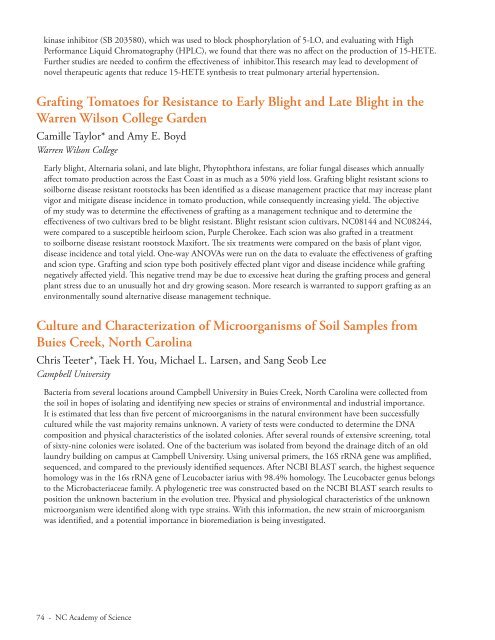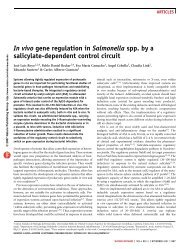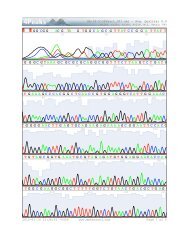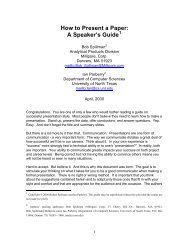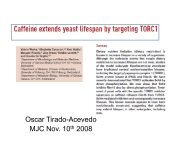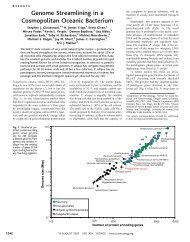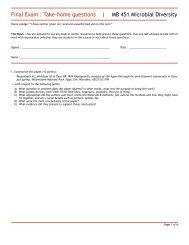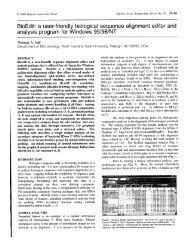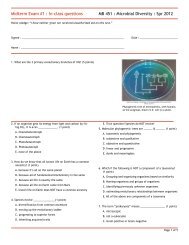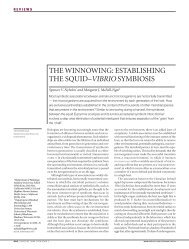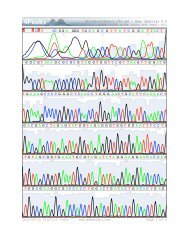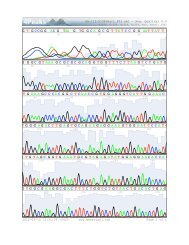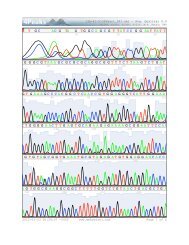Schedule and Program - North Carolina Academy of Science
Schedule and Program - North Carolina Academy of Science
Schedule and Program - North Carolina Academy of Science
Create successful ePaper yourself
Turn your PDF publications into a flip-book with our unique Google optimized e-Paper software.
kinase inhibitor (SB 203580), which was used to block phosphorylation <strong>of</strong> 5-LO, <strong>and</strong> evaluating with HighPerformance Liquid Chromatography (HPLC), we found that there was no affect on the production <strong>of</strong> 15-HETE.Further studies are needed to confirm the effectiveness <strong>of</strong> inhibitor.This research may lead to development <strong>of</strong>novel therapeutic agents that reduce 15-HETE synthesis to treat pulmonary arterial hypertension.Grafting Tomatoes for Resistance to Early Blight <strong>and</strong> Late Blight in theWarren Wilson College GardenCamille Taylor* <strong>and</strong> Amy E. BoydWarren Wilson CollegeEarly blight, Alternaria solani, <strong>and</strong> late blight, Phytophthora infestans, are foliar fungal diseases which annuallyaffect tomato production across the East Coast in as much as a 50% yield loss. Grafting blight resistant scions tosoilborne disease resistant rootstocks has been identified as a disease management practice that may increase plantvigor <strong>and</strong> mitigate disease incidence in tomato production, while consequently increasing yield. The objective<strong>of</strong> my study was to determine the effectiveness <strong>of</strong> grafting as a management technique <strong>and</strong> to determine theeffectiveness <strong>of</strong> two cultivars bred to be blight resistant. Blight resistant scion cultivars, NC08144 <strong>and</strong> NC08244,were compared to a susceptible heirloom scion, Purple Cherokee. Each scion was also grafted in a treatmentto soilborne disease resistant rootstock Maxifort. The six treatments were compared on the basis <strong>of</strong> plant vigor,disease incidence <strong>and</strong> total yield. One-way ANOVAs were run on the data to evaluate the effectiveness <strong>of</strong> grafting<strong>and</strong> scion type. Grafting <strong>and</strong> scion type both positively effected plant vigor <strong>and</strong> disease incidence while graftingnegatively affected yield. This negative trend may be due to excessive heat during the grafting process <strong>and</strong> generalplant stress due to an unusually hot <strong>and</strong> dry growing season. More research is warranted to support grafting as anenvironmentally sound alternative disease management technique.Culture <strong>and</strong> Characterization <strong>of</strong> Microorganisms <strong>of</strong> Soil Samples fromBuies Creek, <strong>North</strong> <strong>Carolina</strong>Chris Teeter*, Taek H. You, Michael L. Larsen, <strong>and</strong> Sang Seob LeeCampbell UniversityBacteria from several locations around Campbell University in Buies Creek, <strong>North</strong> <strong>Carolina</strong> were collected fromthe soil in hopes <strong>of</strong> isolating <strong>and</strong> identifying new species or strains <strong>of</strong> environmental <strong>and</strong> industrial importance.It is estimated that less than five percent <strong>of</strong> microorganisms in the natural environment have been successfullycultured while the vast majority remains unknown. A variety <strong>of</strong> tests were conducted to determine the DNAcomposition <strong>and</strong> physical characteristics <strong>of</strong> the isolated colonies. After several rounds <strong>of</strong> extensive screening, total<strong>of</strong> sixty-nine colonies were isolated. One <strong>of</strong> the bacterium was isolated from beyond the drainage ditch <strong>of</strong> an oldlaundry building on campus at Campbell University. Using universal primers, the 16S rRNA gene was amplified,sequenced, <strong>and</strong> compared to the previously identified sequences. After NCBI BLAST search, the highest sequencehomology was in the 16s rRNA gene <strong>of</strong> Leucobacter iarius with 98.4% homology. The Leucobacter genus belongsto the Microbacteriaceae family. A phylogenetic tree was constructed based on the NCBI BLAST search results toposition the unknown bacterium in the evolution tree. Physical <strong>and</strong> physiological characteristics <strong>of</strong> the unknownmicroorganism were identified along with type strains. With this information, the new strain <strong>of</strong> microorganismwas identified, <strong>and</strong> a potential importance in bioremediation is being investigated.74 - NC <strong>Academy</strong> <strong>of</strong> <strong>Science</strong>


